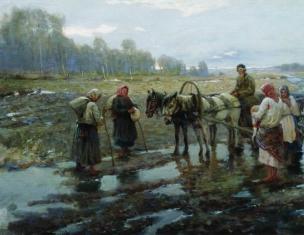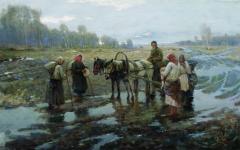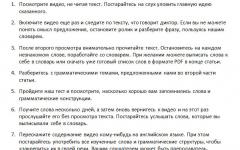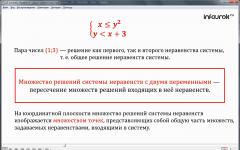Monument to the paratroopers of the 6th company
Almost all the monuments of Pskov are of great value for the city and its residents. In the village of Cherekha, in the Pskov region, there is one monument that commands respect from everyone who visits it. This monument is a reminder of the feat that the paratroopers of the 6th parachute company accomplished.
Many people tend to think that modern people are not capable of feats, and if there are such heroes, then there are only a few of them. However, this opinion is erroneous, and even in the 21st century there are people who are ready to carry out orders at the cost of their lives and cover their comrades with their backs. Take, for example, the famous 6th company. On March 1, 2000, with only 90 people, our fighters held the line against 2,500 militants. Ordinary soldiers and officers stood shoulder to shoulder, fighting an enemy whose numbers were several times greater. Their courage and valor knew no bounds, because each of them knew that this battle would most likely be their last. But no one gave up or turned back, and fought with the enemy to the last.
At the cost of many lives, the order was carried out. Only 6 people survived. This feat will forever remain in the hearts of many. Today we are reminded of this by the monument in Pskov, and by such films as “Breakthrough”, “Russian Sacrifice” and books written based on this heroic story.
On the day when Air Airborne Troops celebrated its 70th anniversary, Russian President Vladimir Putin personally visited the Pskov division and expressed condolences to all the relatives of the victims. He also personally apologized for the miscalculations that were made command staff. As a sign of great sorrow and respect for the heroes, Putin ordered the erection of a monument in their honor, which will remind all Russians of these brave fighters.
In 2002, on August 3, the memorial sculpture was inaugurated. It is located near the checkpoint of the same 104th regiment. The monument represents a huge open parachute; the autographs of all those who gave their lives in that unequal battle are engraved on the inside of the dome. And the crown of the dome is the stylistic star of the Hero of Russia.
The idea of creating such a composition belongs to the Pskov architect Anatoly Tsarik. As the creator himself says, he had no doubt that to create the sculpture it was necessary to take a parachute, which is the main symbol of the Airborne Forces. Under the snow-white dome there is a pedestal made in the shape of a mountain peak. On the granite slabs you can read the names of all 84 heroes. The slab facing the highway is decorated with a gold star. It contains the names of those who were awarded the title of Hero of Russia.
On the pedestal, in the center of the composition, 84 memorial candles rise, after it gets dark, each of them gives off a faint glow, paying tribute to the memory of their heroes.
| Monument | |
| Dome | |
|---|---|
| Country | Russia |
| Village | Cheryokha |
| Architect | Anatoly Tsarik |
| Date of construction | year |
| Height | 20 m |
Monument to the 6th company ("Dome") - a monument in the village of Cherekha, Pskov region, designed to perpetuate the memory of the feat of 84 soldiers of the 6th parachute company of the 104th Guards Parachute Regiment of the 76th Guards Airborne Division.
Location
The monument is located on a small area between the federal highway “Pskov” and the checkpoint of the 104th Airborne Assault Regiment, stationed in Cheryokha. The stone fence of the checkpoint and military camp, imitating fortress walls with guard towers in the corners, limits the area from the north, east and south. The western border is the above-mentioned highway. At the northern and southern ends of the square there is a pedestrian crossing across the highway, regulated by a traffic light with a digital display.
The close proximity of the regional center is emphasized by the roadside welcome sign “Pskov”, located approximately one hundred meters north of the monument in the line of sight.
Description
The author of the monument was Pskov architect Anatoly Tsarik. He took as a basis main symbol paratroopers - parachute. The snow-white metal dome rests with steel slings on a pedestal stylized as a tetrahedral mountain peak. The pedestal in the center of each face is covered by trapezoidal slabs of red granite, which in plan form the image of the St. George Cross. Granite slabs contain a list dead soldiers from 84 surnames. The western plate, facing the highway, is marked with the gold star of the Hero of Russia and stores the names of 21 paratroopers awarded this honorary award. On the remaining slabs, 63 military personnel awarded the Order of Courage are grouped, as evidenced by the award symbol placed at the top of each slab.
The inside of the parachute dome is covered with images of the autographs of fallen paratroopers, and the dome is crowned with the stylistic star of the Hero of Russia, enclosed in the pole hole. The central axis of the monument is a composition of 84 memorial candles pointing upward. At night, each of the candles lights up with a dim orange light. On west side of the monument, at the foot of the bunch of candles, there is a shield with the inscription: “6th Company Grateful Russia”. In addition to the monument itself, the memorial complex is complemented by a memorial stone located on the northeastern edge of the square. The granite plaque attached to it reads:
Years of creation:

The monument was erected in the Northern microdistrict of Voronezh at the landing site of the first landing force in the USSR
Description of the monument:
For the first time, the landing of military paratroopers and the release of cargo with weapons and ammunition for paratroopers took place near Voronezh on August 2, 1930. Now this day is celebrated annually as the birthday of the Russian airborne troops, and Voronezh is rightfully considered the homeland Airborne Forces
The first monument to paratroopers was erected on this site on August 2, 1997. This is a red granite block, on the front surface of which there is a metal plate with the words: “HERE ON AUGUST 2, 1930, FOR THE FIRST TIME AN AIR LANDING IN THE NUMBER OF TWELVE PEOPLE WAS LANDED IN THE USSR.”
In our time, the field where the first paratroopers landed has turned into a residential neighborhood built up with multi-story buildings, and the vacant lot near the Academy of Arts, where the first monument was erected, has turned into a large park called Victory Park.
On September 4, 2010, the grand opening of the monument “Voronezh - Homeland of the Airborne Forces” took place in Victory Park. It is a sculptural composition consisting of two bronze figures - a paratrooper dressed in military uniform 30s of the last century, and next to him is a teenager holding a model airplane in his hand. A parachute canopy, a nine-meter-high steel structure, soared above them. The pedestal of the monument is made of polished granite.
Pskov district, village Cherekha
Historical background
Cherekha is a village in the Pskov district of the Pskov region of Russia. Administrative center Yadrovskaya volost, Pskov region. It is located between the Velikaya, Cheryokha and Mnoga rivers, 100 meters south of the southern border of the city of Pskov, in fact being its suburb. Located on the St. Petersburg - Pskov - Nevel M-20 highway and the Pskov - Ostrov railway. In the village there is the Cheryokha railway station, built around 1896 by Pskov entrepreneur Georg Frantsevich Wikenheiser and for a certain time called the “Wickenheiser platform”; on the map of 1915 the name “Cheryokha platform” appeared, on maps of the 1940s - “Cheryokha station”. Cheryokha railway station, built by Wikenheiser
In Cheryokha there is a monument to the 6th company that died in March 2000 in Chechnya. One of the air assault regiments (104th Guards Airborne Regiment) of the 76th Guards Airborne Division of the Russian Airborne Forces is located in Cheryokha. The first mention of the village of Cherekha in the Pskov chronicles dates back to 1329.
Monument to the 6th Company (“Dome”) - a monument in the village of Cherekha, Pskov Region, designed to perpetuate the memory of the feat of 84 soldiers of the 6th Airborne Company of the 104th Guards Parachute Regiment of the 76th Guards Airborne Division .
It was built in accordance with Decree of the President of Russia No. 1334 of July 21, 2000 “On perpetuating the memory of paratroopers.” Opened on August 1, 2002. Architect - Anatoly Tsarik.
At the height of the Second Chechen campaign, on February 29, 2000, in the Argun Gorge, at height 776, a clash occurred between large forces of Chechen separatists retreating from encirclement and a detachment of Russian paratroopers, composed mainly of the 6th company of the 2nd battalion of the 104th parachute regiment of the 76th Pskov division.
During the desperate battle, the defenders showed massive heroism, but the forces were too unequal. Almost all the paratroopers died.
It was on the first day of spring 2000 that paratroopers of the 6th company under the command of Lieutenant Colonel Mark Evtyukhin entered into an unequal battle with Khattab’s militants near Ulus-Kert. They prevented the breakthrough of 2.5 thousand members of illegal gangs, destroying 700 of them. Of the 90 fighters, 84 died. For their courage, 22 military personnel were awarded the title of Hero of Russia, 69 soldiers and officers were awarded the Order of Courage, 63 of them posthumously.
Almost all the officers died in the first minutes of the battle. Trained snipers worked at the paratroopers' positions. Later it would become known that Khattab brought the best mercenaries, among whom were many Arabs, to the Argun Gorge.
They walked without even shooting. In the last attack - in full height. Later, strong drugs would be found at the heights, which were injected into themselves by militants twenty times superior to the paratroopers. But the sixth one still fought.
The dramatic course and outcome of the battle caused a significant resonance in Russian society.
For this feat, 22 guardsmen (21 of them posthumously) were awarded the title of Hero of Russia, 69 soldiers and officers of the 6th company were awarded the Order of Courage (63 of them posthumously). At the end of July 2000, President Russian Federation V.V. Putin ordered the installation of a monument to heroically fallen soldiers in Pskov.
The monument is located on a small area between the Pskov federal highway and the checkpoint of the 104th Airborne Assault Regiment stationed in Cheryokha. The stone fence of the checkpoint and military camp, imitating fortress walls with guard towers in the corners, limits the area from the north, east and south.
The western border is the above-mentioned highway. At the northern and southern ends of the square there is a pedestrian crossing across the highway, controlled by a traffic light with a digital display.
The close proximity of the regional center is emphasized by the roadside welcome sign “Pskov”, located approximately one hundred meters north of the monument in the line of sight.
The author of the monument was Pskov architect Anatoly Tsarik. He took as a basis the main symbol of the paratroopers - the parachute. The snow-white metal dome rests with steel slings on a pedestal stylized as a tetrahedral mountain peak.
The pedestal in the center of each face is covered by trapezoidal slabs of red granite, which form an image in plan St. George's Cross. Granite slabs contain a list of fallen soldiers from 84 names.
Lists of fallen soldiers
The western plate, facing the highway, is marked with the gold star of the Hero of Russia and stores the names of 21 paratroopers awarded this honorary award. On the remaining slabs, 63 military personnel awarded the Order of Courage are grouped, as evidenced by the award symbol placed at the top of each slab.
The inside of the parachute dome is covered with images of the autographs of fallen paratroopers, and the dome is crowned with the stylistic star of the Hero of Russia, enclosed in the pole hole. The central axis of the monument is a composition of 84 memorial candles pointing upward.
At night, each of the candles lights up with a dim orange light. On the western side of the monument, at the foot of a bunch of candles, there is a shield with the inscription: “6th Company Grateful Russia” .
From the press release: On August 5, 2012, in the village of Demyansk (Novgorod Region), a grand opening of a monument to the paratroopers of the 1st MVDBr (maneuverable airborne brigade) and the 204th VDBr (airborne brigade), who died in 1942 during a special reconnaissance mission, is planned. sabotage combat operation. The opening of the monument is timed to coincide with the 70th anniversary of the large-scale, but little-known Demyansk landing operation. The monument was made and installed with funds raised by those who were not indifferent to the feat. Soviet soldiers citizens and organizations with the support of the Demyansk search team and the administration of the Demyansk district Novgorod region.
Brief historical background
At the beginning of January 1942, as a result of the offensive of the Red Army by the forces of the North-Western and Kalinin fronts, south of Lake Ilmen and east of the city of Staraya Russa, 6 divisions of the Wehrmacht, SS and units attached to them, as well as rear units of the Second Army Corps, were partially surrounded - only up to 100 thousand Germans.
This offensive was part of the “great counter-offensive near Moscow” and part of the Toropetsko-Kholm operation. The Red Army soldiers reached Kholm, Staraya Russa. As a result of the development of this and some other private operations, later, in mid-February, the so-called “Demyansk Cauldron” was formed - the encirclement of a German group that had wedged itself into our defense, initially aimed at Bologoye with the task of “saddled” Oktyabrskaya railway(Moscow-Leningrad roads).
In the spring of 1942 in the Demyansk region, in German rear, with the forces of two MVDBr and the 204th Airborne Brigade, as well as the separate ski battalions assigned to them, the command of the Red Army tried to put an end to the enemy’s encircled Demyansk group from the inside.
The paratroopers were given the most difficult tasks: concentrating in the German rear, destroy the enemy airfield, thereby disrupting the supply of goods to the encircled German troops and prohibit the evacuation of the wounded; destroy the headquarters of the 2nd Army Corps, which would lead to disorganization of the interaction of all encircled units; destroy enemy rear communications; clear the enemy from the area around the Knevitsa-Lychkovo railway in the north of the “Demyansk Pocket” and hold it, which would allow the road to be freely used for supplying and maneuvering troops of the North-Western Front.
More than 9 thousand soldiers and commanders took part in the operation, which was initially planned to be fleeting. But fighting were significantly delayed and were carried out by paratroopers in the most unfavorable conditions: the severe February frosts of 1942 gave way to a wet thaw, the soldiers fighting behind enemy lines were in dire need of food and ammunition. Soon hunger began, the sick and frostbitten appeared, and there were many wounded. There was an acute shortage of ammunition. The surviving paratroopers of the 1st MVDB noted in their memoirs after the war that no one monitored the filling of their duffel bags before the operation, and the soldiers, pushed by patriotism, filled their duffel bags with cartridges rather than with a balanced food ration.
In the cold, in wet clothes, in the forest, under fire - the supplies of food brought disappeared very quickly. People were tired and hungry; the mobility of the groups dropped significantly; The constant shelling and bombing from airplanes and the actions of enemy ski patrols put pressure on the psyche.
Nevertheless, the paratroopers attacked the enemy more than once, trying to complete the tasks set by the command. During the fighting, most of the paratroopers died or went missing. The losses of the 1st MVDBR amounted to more than 2,600 people out of 3,000. These losses included prisoners, killed and “missing” people. The 204th Brigade lost more than 1,800 out of 2,000. In general, out of 5,000 people of the two brigades, no more than 432 people were able to get through to their own (in the period until April 10, of which 87 people were from the 204th brigade). About 150 more people were evacuated by plane (wounded and command and logistics personnel). Individual groups the wounded went out to their own, sometimes having more than 2 weeks behind them without food, without ammunition, moving through forests and swamps at night, avoiding roads.
About 500 people left the formation of the 2nd MVDBr and part of the 204th brigade (in the north of the pocket) across the front line. For a long time, until mid-May, single paratroopers and their small groups went out to their own. A few surviving paratroopers managed to join the partisan detachments operating in the rear of the Demyansk Pocket.
In memory of fallen heroes
The results of the operation are not included in the official “broad” historiography. Until now, there has been no worthy monument to the paratroopers who honestly and completely fulfilled their duty to the Motherland. And most of the dead and missing paratroopers have not been found or buried to this day.
Work to search for the remains and establish the names of dead and missing paratroopers has been carried out for several decades in the Demyansky district of the Novgorod region by the search engines of the Demyansk detachment (commander Anatoly Pavlov), the Dolg search association from Kirov region(commander of the Kirov search engines - Yuri Semenenko) and the search team of school No. 2 in the city of Kirovo-Chepetsk. To date, search engines have found more than 1,000 dead participants in the landing operation. Several years ago, fighters of the Demyansk search squad established the first memorial sign to the paratroopers of the 204th Airborne Brigade who died in battle near the village of Igozhevo.
In 2012, 70 years after the tragic Demyansk landing operation, a memorial monument was opened in the village. The author of the sculptural composition is sculptor Mikhail Vladimirovich Pereyaslavets. Student of Lev Kerbel, sculptor at the studio of military artists named after M.B. Grekova, People's Artist of Russia, Professor of the Department of Sculpture at the Moscow State Academic Institute named after Surikov, full member Russian Academy Arts In 1968, Mikhail Pereyaslavets entered the institute, and in the early 70s he began professional activity like a sculptor.
Mikhail Pereyaslavets is the author of many monuments, among them: Surikov in Moscow, Ershov in Tobolsk, Pokryshkin in Novosibirsk, Catherine the Great (who is Sophia Frederick Augustus, Princess of Anhalt-Zerbst) in Zerbst (Germany). One of his sculptures, installed in Moscow, is dedicated to the feat of the “winged infantry”. The monument to the heroes of the 6th Airborne Company of the 104th Guards Parachute Regiment of the 76th Airborne Division was erected in 2002 next to the Central Museum of the Armed Forces.
Work on the monument began in 2010. During the design we had to take into account a whole series factors, in particular - anti-vandal elements are also included in the design. The sculpture is made from a single piece of gabbro (diabase) and weighs more than 8 tons including the pedestal. The height of the monument is more than three meters.
The preliminary estimate for the design and installation of the monument amounted to more than 2 (two) million rubles. Money for the construction of the monument was collected from the personal funds of citizens. The overwhelming majority of the work was personally financed by Alexei Pankratov, an entrepreneur from Moscow, head of Delo Tekhniki LLC, who had been studying the history of the Demyansk landing operation for many years.
The governor of the Novgorod region Sergei Mitin, the commander of the Airborne Forces of the Russian Federation, Colonel General Vladimir Shamanov, the auditor of the Accounts Chamber of the Russian Federation Vladimir Katrenko, and veterans of the Great Patriotic War were invited to the opening ceremony of the monument. Patriotic War, students of military-patriotic clubs and paratroopers of the oldest currently existing airborne formations - the 76th Guards Chernigov Red Banner Air Assault Division. By order of the USSR Minister of Defense dated April 20, 1985, V. F. Margelov was included in the lists of this particular unit as an Honorary Soldier.
It is no coincidence that the grand opening of the monument to paratroopers is held on August 5, simultaneously with the celebration of “Demyansk Day”. Veterans of the Great Patriotic War and the Airborne Forces, current paratroopers, students of military-patriotic clubs, schoolchildren, guests of Demyansk and its residents will gather together to honor the memory of the soldiers who died for our Motherland 70 years ago. We remember our heroes and are proud of them.
Residents of Demyansk and guests of the village gathered on the morning of August 5 in a small square at the crossroads
At the parachute-covered monument to the paratroopers, soldiers from the reconnaissance company of the oldest existing airborne formations - the 76th Guards Chernigov Red Banner Airborne Assault Division - froze in a guard of honor.
Next to them are cadets of the military-patriotic club “Young Paratrooper” of the Moscow City Palace of Children's (Youth) Creativity on Sparrow Hills
A few front-line veterans also came to the opening ceremony
The governor of the Novgorod region, the head of the administration of the Demyansky district and the chairman of the Council of Commanders of the Dolina search expedition arrived.
Alexey Pankratov, the head of the Moscow company Delo Tekhniki and the main sponsor of the entire project with the monument, talks about the monument and the operation. Although, the word “sponsor” is completely unsuitable here, because Alexey not only financed most of all the work, but for many years he has personally been studying the history of the Demyansk landing operation both in archives and in the swamps
Representative of the Russian Airborne Forces - Colonel Gudymenko, assistant commander of the 76th Guards Chernigov Red Banner Airborne Assault Division for work with personnel
The governor of the Novgorod region and the head of the Demyansky district solemnly remove the parachute cover from the monument, the Russian Anthem is played
The son of one of the paratroopers who fought near Demyansk in the spring of 1942 arrived at the opening.
A resident of Demyansk, who survived the war, said a few words. childhood occupation and knowing first-hand what exactly that war was like
After the opening of the monument, the paratroopers marched solemnly, with unfurled banners and accompanied by the beating of drums, to the central square of Demyansk to congratulate the people of Demyansk on the village day
After the official part was over, there was another unofficial part. Soldiers of the Demyansk search detachment and representatives of the Russian Airborne Forces went to the village of Igozhevo, where the paratroopers found by the Demyansk search detachment are buried
Those who distinguished themselves were awarded certificates of honor on behalf of Airborne Forces Commander Russian Federation Colonel General Shamanov
In response, the commander of the Demyansk search detachment, Anatoly Stepanovich Pavlov, donated several exhibits found at the site of the death of the paratroopers of the 204th Airborne Division to the museum of the Pskov Airborne Division. The detachment commander himself was awarded the Margelov medal by order of the Airborne Forces commander. Anatoly Stepanovich’s second award on this day was the Badge of Distinction of the Novgorod Region “For Services to the Novgorod Region”
“The insignia of the Novgorod region “For services to the Novgorod region” is a form of encouragement of citizens for a significant contribution to the socio-economic development of the Novgorod region, merits in government, scientific, creative and other activities, many years of fruitful work aimed at improving the well-being of residents of the Novgorod region. The insignia is awarded to citizens of the Russian Federation, citizens (subjects) of other states, and stateless persons.
A proposal for awarding a citizen with an insignia is submitted to the Novgorod Regional Awards Commission by the Governor of the Novgorod Region, the Chairman of the Novgorod Regional Duma, the heads of municipalities areas ( municipal districts and urban district), on the territory of which the citizen nominated for award of the insignia resides and (or) carries out labor activities.”
Work to search, identify and perpetuate the memory of the fallen paratroopers will, of course, continue. If you would like to provide financial assistance to the Demyansk search team, you can do this through Search Team Assistance Fund.
On behalf of the search engines and personally, I deeply thank everyone who had a hand in organizing the events for the opening of the monument in Demyansk. Thank you so much and regards!
P.S. For the opening of the monument, commemorative T-shirts were printed, like these. There are a small number of all sizes left, if anyone wants to get one, then .







